



Next: Windowing Histogram Analysis
Up: Shading and Lighting Normalization
Previous: Histogram Fitting
It is possible to merely apply histogram equalization [14] to an
image to correct lighting by imposing a uniform histogram distribution on the
image. However, well-lit faces do not have a uniform histogram distribution
and this process gives a surreal, unnatural illumination to the face.
Recognition does not necessarily require ``natural'' illumination to be
effective. It requires normalized illumination. However, a subtlety arises.
The nature of the target histogram we wish to generate from our current histogram
(be it Gaussian, uniform or some other distribution) will cause a ``weighting''
effect on the recognition. Regions which are extremely illuminated (very dark
or bright) will contain more variance than normally lit regions and hence a
``variance'' type of analysis will tend to weight them more strongly during
recognition. Since it is unknown which histogram configuration is optimal for
recognition, we opt to normalize the histograms of the faces by giving give
them an aesthetically appealing illumination.
Texts such as [14] encourage the normalization of a poorly
illuminated image via histogram fitting to a similar, well illuminated image.
For example, a poorly illuminated road map can be enhanced quite well by
histogram fitting to a well-illuminated road map. Thus, a well illuminated
average human face4.2is analyzed and
its histogram is determined. This histogram will form our G(i) destination
histogram in the fitting process. We ``histogram-fit'' new faces to this
average well-lit face histogram and noted its strong effectiveness visually.
This technique was employed successfully by Phillips and Vardi
[33]. However, they did not utilize a ``mean'' face but rather a
random ``sample'' face to generate G(i). The histogram of the mean face (our
target histogram) is depicted in Figure ![[*]](http://vismod.www.media.mit.edu/vismod/support/latex2html-98//cross_ref_motif.gif) .
.
Figure 4.17:
Histogram of the mean face.
 |




Next: Windowing Histogram Analysis
Up: Shading and Lighting Normalization
Previous: Histogram Fitting
Tony Jebara
2000-06-23
![[*]](http://vismod.www.media.mit.edu/vismod/support/latex2html-98//cross_ref_motif.gif) .
.
![[*]](http://vismod.www.media.mit.edu/vismod/support/latex2html-98//cross_ref_motif.gif) .
.